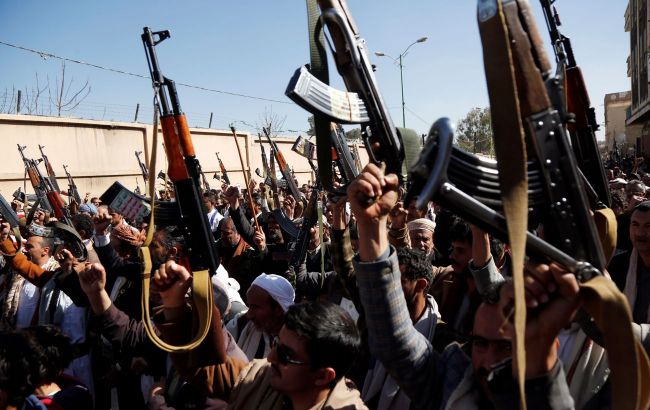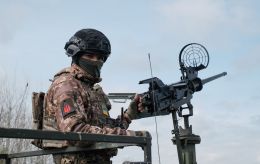Yemen's Houthis and their attacks on ships in Red Sea: Overview
 The United States and United Kingdom have launched airstrikes against Houthis in Yemen (Getty Images)
The United States and United Kingdom have launched airstrikes against Houthis in Yemen (Getty Images)
Last night, the United States and the United Kingdom launched powerful strikes against Houthi targets in Yemen. This was in response to sustained Houthi attacks on shipping lanes in the Red Sea over the past few months.
Sources used: statements by U.S. President Joe Biden, UK Prime Minister Rishi Sunak, Pentagon Secretary Lloyd Austin, U.S. Central Command (CENTCOM), Sky News, CNN, and The Guardian.
Who are Houthis?
The Houthis are a Shiite Zaidi paramilitary group operating in Yemen that emerged in the 1990s against the religious influence of Saudi Arabia. The group is named after its founder and former leader Hussein al-Houthi, who was killed by the Yemeni army in September 2004. In particular, that year, the self-proclaimed Imam Hussein al-Husi raised an anti-government rebellion, accusing the Yemeni authorities of so-called "discrimination against the Zaidi population." So after his death, the leadership of the group passed to his brother Abdel-Malik al-Houthi.
In 2009, with the support of Saudi Arabia, government forces were able to suppress the rebellion. In February 2010, a ceasefire agreement was signed between the Houthis and the Yemeni authorities.
Houthis profess the Zaidi madhhab, a kind of sect within the Shiite branch of Islam. They claim to be "protecting Shiism from the influence of Sunni Islam," which is practiced by the majority of the country's population. Zaidis live mainly in northern Yemen, making up about a third of the country's population. The Yemeni government accuses the Houthis of enjoying Iranian support.
The Ansar Allah group is considered to be the movement's fighting wing. In November 2014, the UN Security Council imposed sanctions on the group's military leaders Abdel-Khalid al-Houthi and Abdullah Yahya al-Hakim for "threatening peace, stability of the country, and obstructing the political process".
The group also participated in the Yemeni revolution of 2011, gaining additional territory. Since then, it has expanded its sphere of influence and now controls most of Yemen's western coast up to the Bab al-Mandeb Strait, a 16-mile stretch of water that marks the entrance to the Red Sea.
 Photo: Houthis control most of Yemen (ACAPS Analysis Hub)
Photo: Houthis control most of Yemen (ACAPS Analysis Hub)
In January 2021, the United States designated the Houthis as a terrorist organization, raising concerns about a shortage of humanitarian aid in Yemen, but this position was reversed a month after Joe Biden became president of the United States.
What is happening in Red Sea and why are Houthis attacking ships there?
The Red Sea is one of the densest shipping lanes in the world, located south of the Suez Canal, the most important waterway connecting Europe to Asia and East Africa. Yemen is located along the southeastern coast of the sea, where it flows into the Gulf of Aden.
After the outbreak of the armed conflict between Israel and Palestinian militants led by Hamas, which broke out on October 7, 2023, the Houthis targeted the Red Sea shipping lanes. In this way, they demonstrate their support for the Palestinian group Hamas. Attacks on ships have forced the world's largest shipping companies to avoid the area.
The situation in the waters escalated on November 19, when Houthi rebels seized the cargo ship Galaxy Leader (a UK vessel operated by a Japanese company) with 25 crew members on board in the Red Sea, including Ukrainians.
The group stated that it would target all ships owned or operated by Israeli companies or flying the Israeli flag. However, the Israeli army stated that the ship was sailing from Türkiye to India and had civilians from various countries on board, but not Israel. The IDF called the seizure of the ship a "serious incident with global implications."
This was followed by numerous attacks on ships by Houthis, mostly unsuccessful, but many shipping companies decided to bypass the route, which significantly increased the time and cost of voyages.
In particular, in recent weeks, merchant ships from different countries have come under fire from Yemen. In addition, attacks with missiles and drones have been directed at warships from different countries already patrolling the region. In particular, there were attempts to fire at U.S. ships. There are also reports of drones being shot down by UK and French ships.
U.S. and allies' reaction
On December 18, the United States announced the launch of Operation Prosperity Guardian in response to the Houthi attacks to jointly address security issues in the southern Red Sea and the Gulf of Aden. The operation brought together mostly NATO allies and some other countries.
In particular, in addition to the United States, the following countries joined the international mission: The United Kingdom, Bahrain, Canada, France, Italy, the Netherlands, Norway, Seychelles, and Spain.
Initially, warnings were issued to the Houthis, but they ignored them and continued to attack ships in the Red Sea. So this week, tensions escalated after a UK warship, on a joint patrol with a U.S. ship, shot down seven drones launched by the Houthis to repel a major drone and missile attack.
According to U.S. estimates, this was the 26th Houthi attack on a commercial vessel since November 19, when terrorists seized the Galaxy Leader.
U.S. and UK strikes against Houthis
It seems that the patience of the United States and the United Kingdom has seriously broken down and last night they launched air strikes on Houthi bases in Yemen. These strikes were a response to terrorist attacks on shipping lanes in the Red Sea.
Alex Grynkewich, the head of the U.S. Central Command Air Force, said that the military had struck 60 targets in 16 locations in Yemen. More than 100 different munitions (precision bombs and air- and sea-launched cruise missiles) were used.
According to CNN, the U.S. used bombers and Tomahawk cruise missiles. Reuters writes that the strikes were carried out by fighter jets, ships, and submarines.
U.S. Secretary of Defense Lloyd Austin said that the target of U.S. strikes in Yemen was ground infrastructure for launching drones and missiles. Interestingly, he directed the operation directly from the hospital where he was being treated for prostate cancer.
U.S. President Joe Biden also issued statement
"These strikes are a direct response to unprecedented Houthi attacks on international vessels in the Red Sea, including the first-ever use of anti-ship ballistic missiles," the American leader said.
UK Prime Minister Rishi Sunak also informed about the strikes against the Houthis.
"The UK Air Force has carried out targeted strikes on military targets used by the Houthis in Yemen," Sunak said and called on the Houthis to stop attacking ships in the Red Sea and take steps to de-escalate.
In turn, the countries of the coalition created to protect shipping in the Red Sea from Yemeni Houthis issued a joint statement. The statement by the United States and the United Kingdom, as well as Australia, Bahrain, Canada, Denmark, Germany, the Netherlands, New Zealand, and South Korea, said that "the strike on Houthi military targets was carried out following the inherent right of states to individual and collective self-defense."
The Houthi leader Abdul-Malik al-Houthi has already issued a "reaction". He warned of a so-called "big" response if the United States and "its allies continue military attacks." Terrorist Russia also took part in the situation, convening a meeting of the UN Security Council today on the situation in Yemen.
What economic consequences will Red Sea crisis have?
There is growing concern about the global economic impact of disruptions to shipping through the vital Red Sea, as other, longer alternative routes for ships increase the cost of trade and cause inflation.
This is because about 12% of the world's total shipping passes through the Suez Canal, which connects the Mediterranean and Red Seas and allows for the shortest possible route between Europe and Asia.
The ships mainly transport oil and liquefied natural gas from the Persian Gulf, as well as consumer goods and electrical appliances from China, Taiwan, and Bangladesh.
The route is also key for food and beverage supply chains, with tea and coffee transported from East Africa, wine from Australia and New Zealand, frozen meat from Thailand, and rice from Cambodia.
Marco Forgione, director general of the Institute for Export and International Trade, told Sky News in December that oil prices have already started to rise.
He warned that delaying ships in the wrong place and causing congestion in ports has led to higher prices - meanwhile, shortages of goods will be felt in January, February, and possibly beyond.
"Unfortunately, there is a significant risk of rising inflation and rising costs for consumers, with the situation getting worse and worse," he said.

